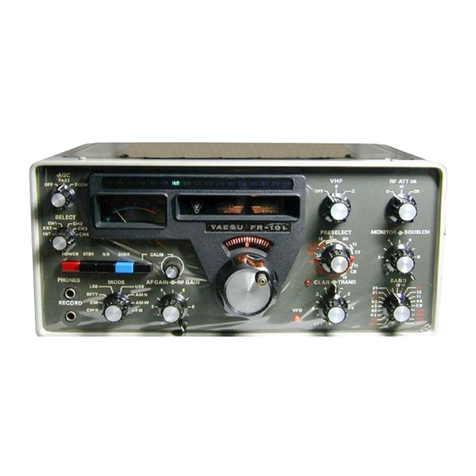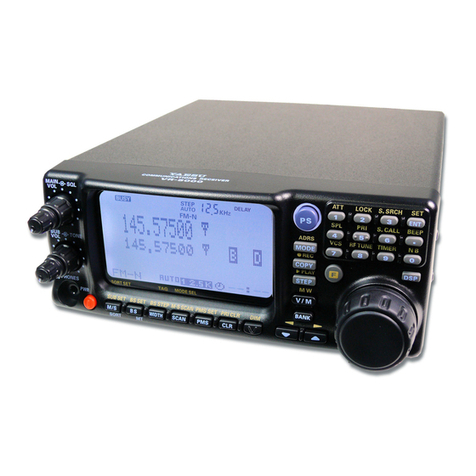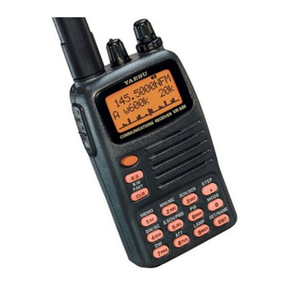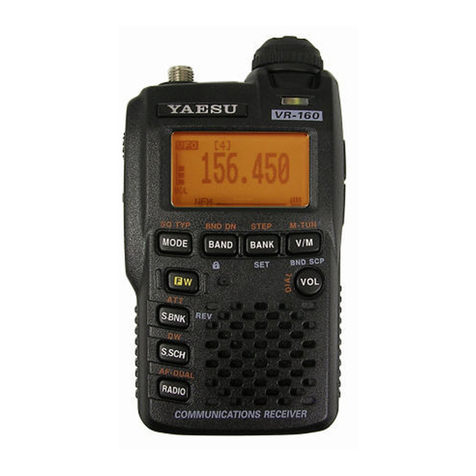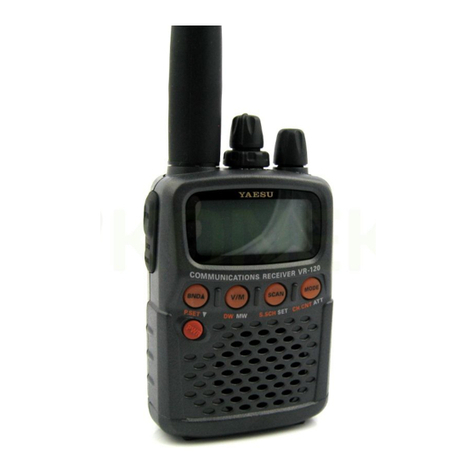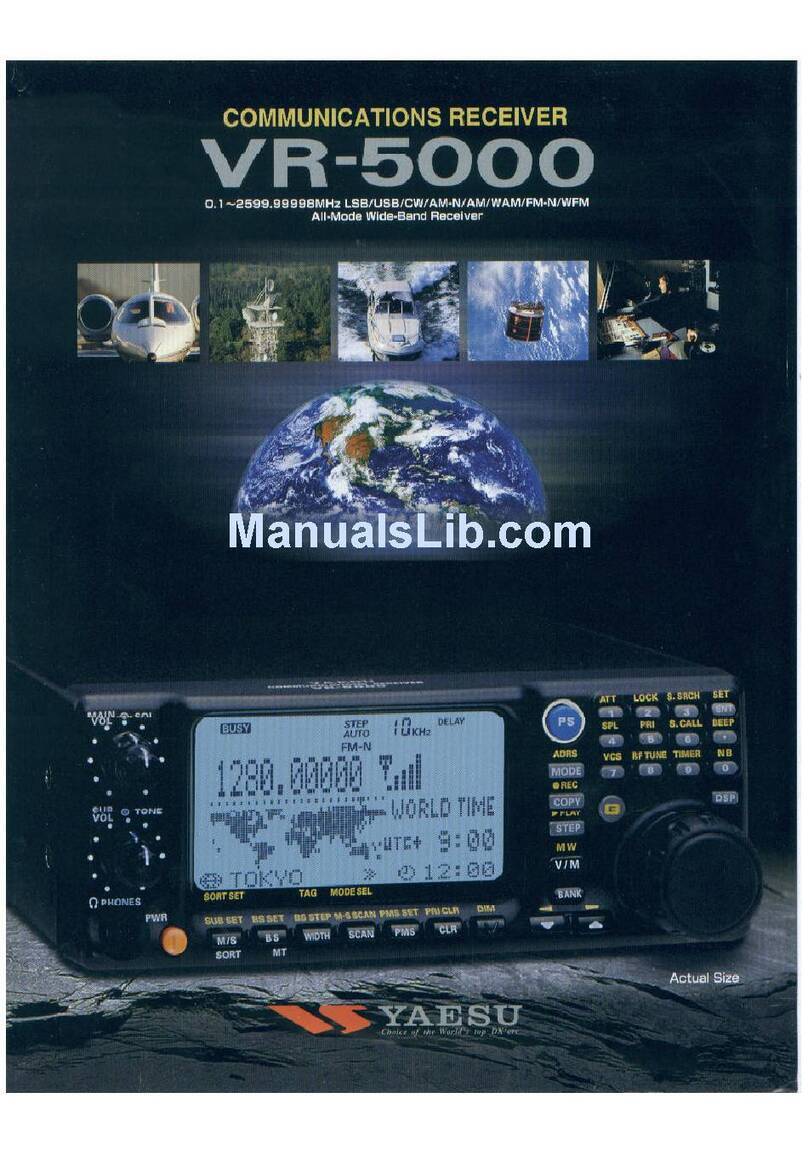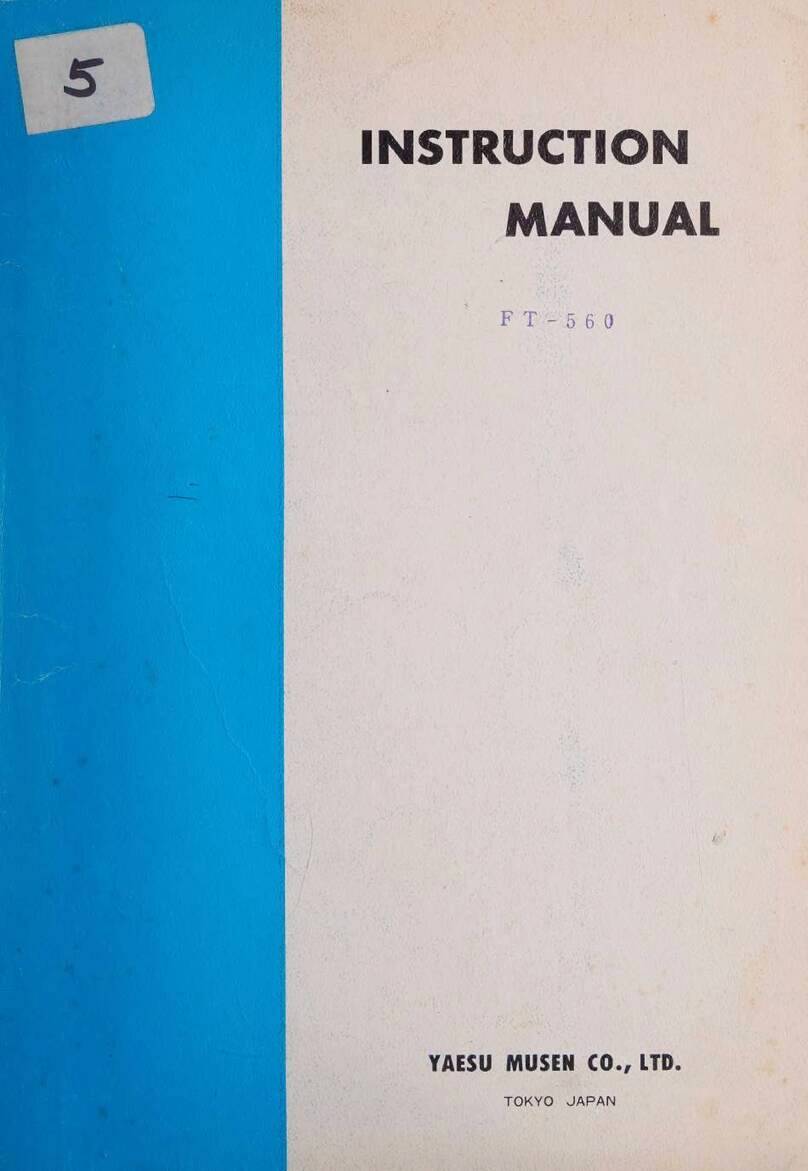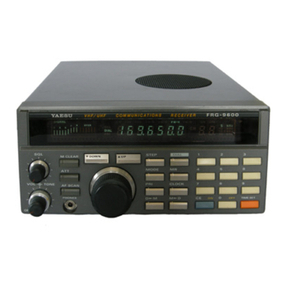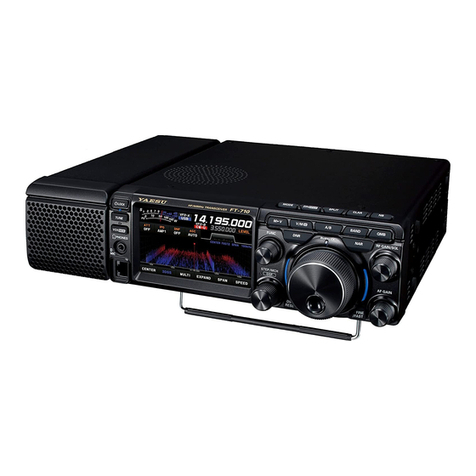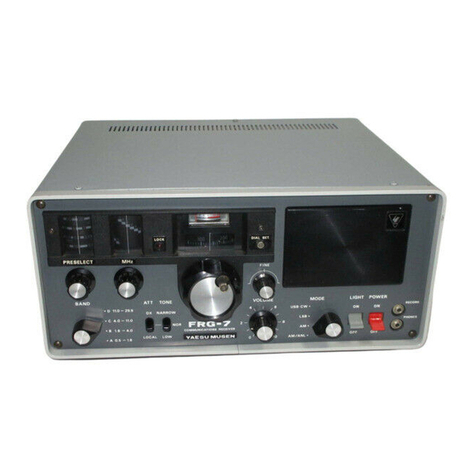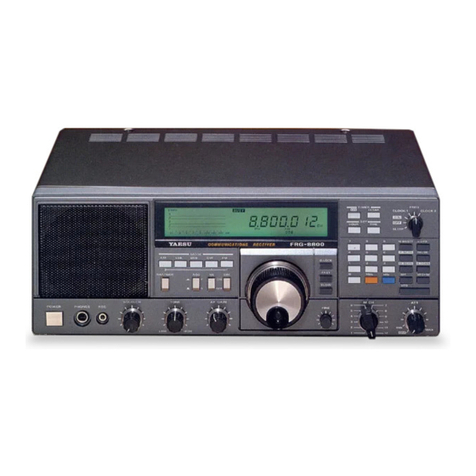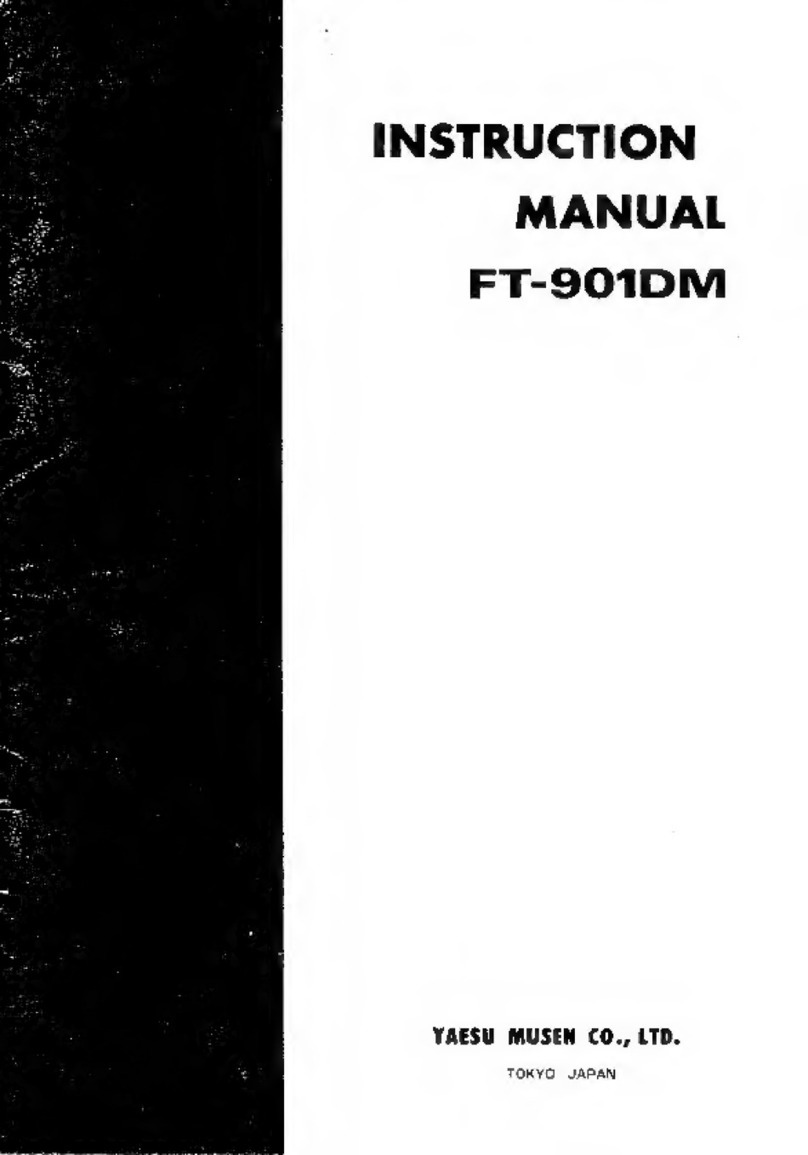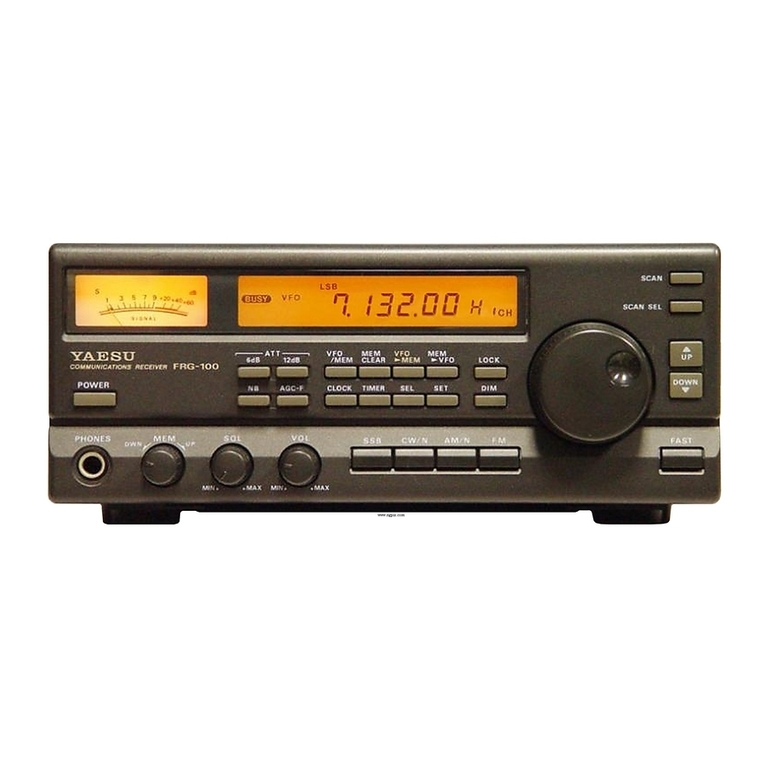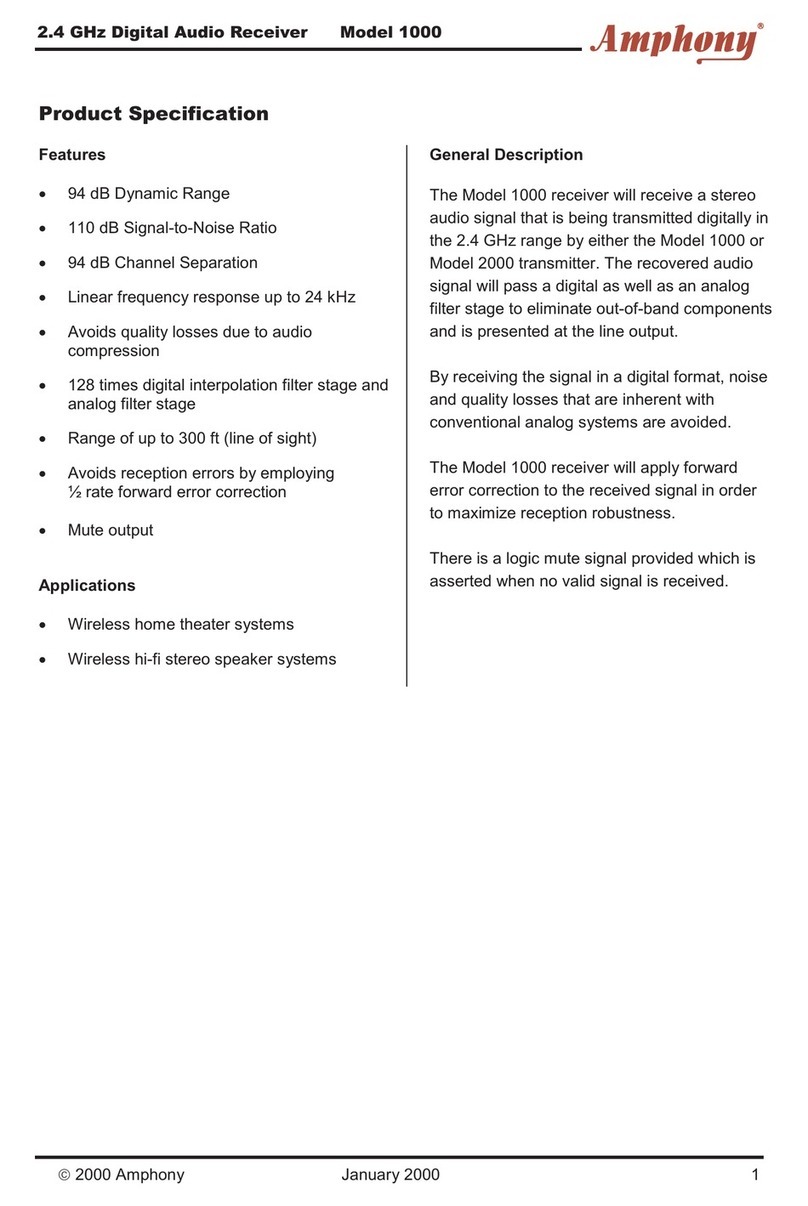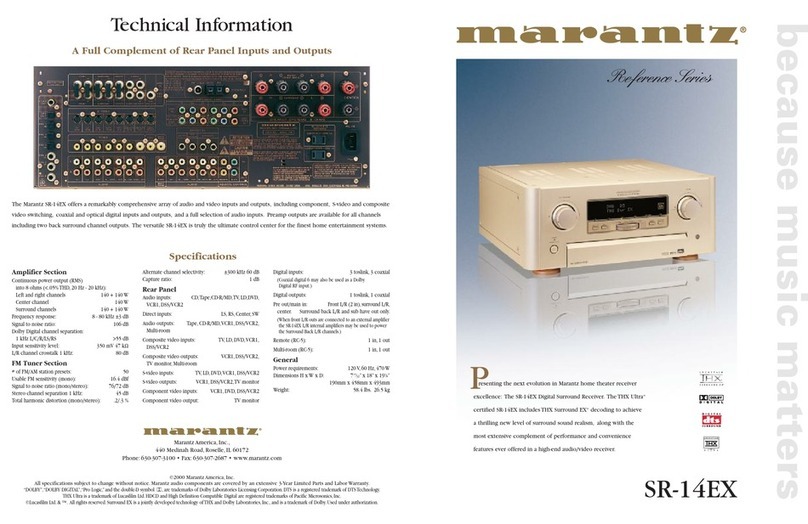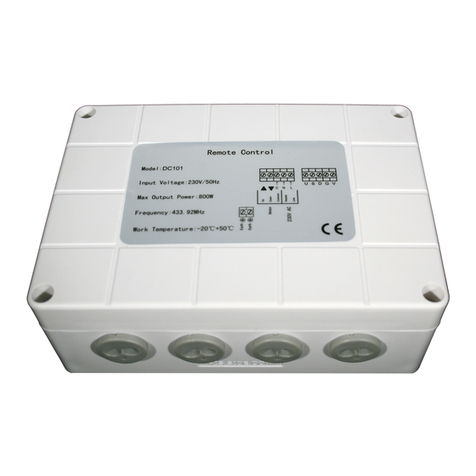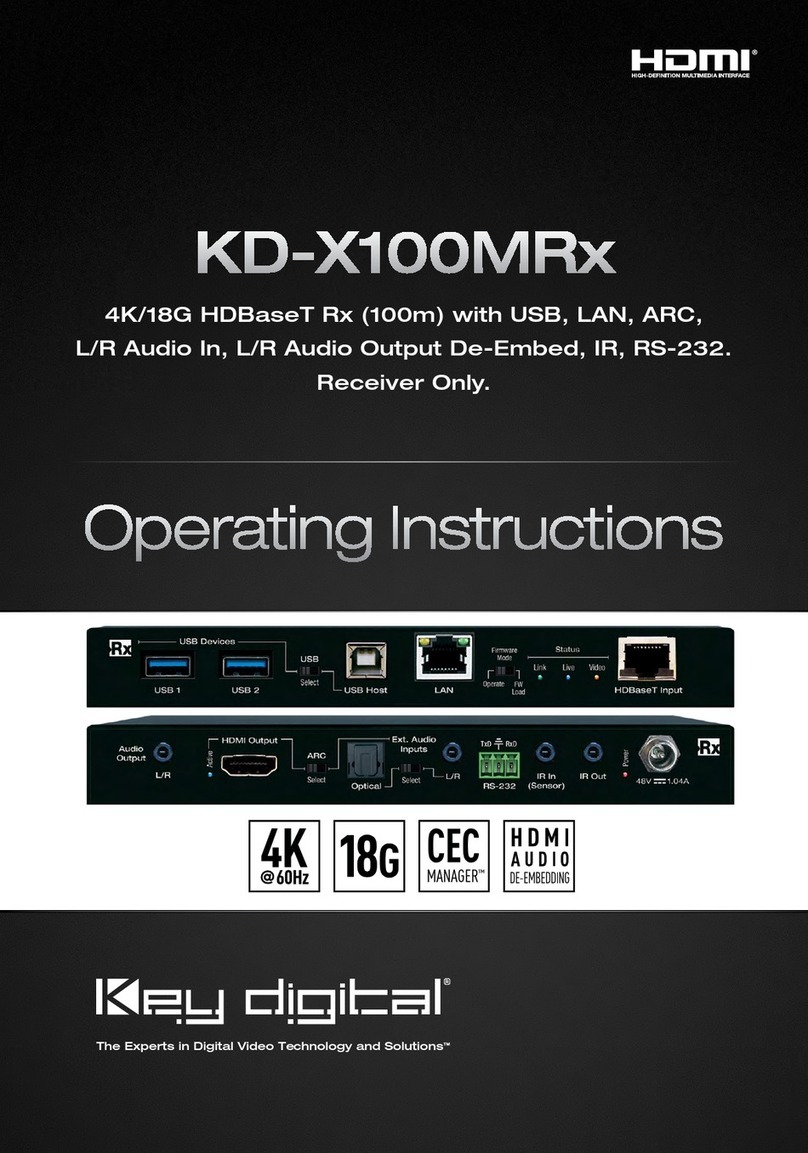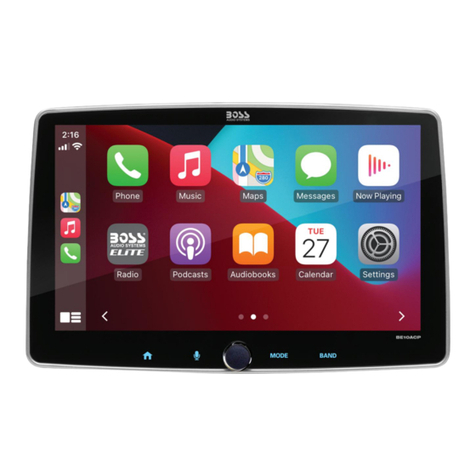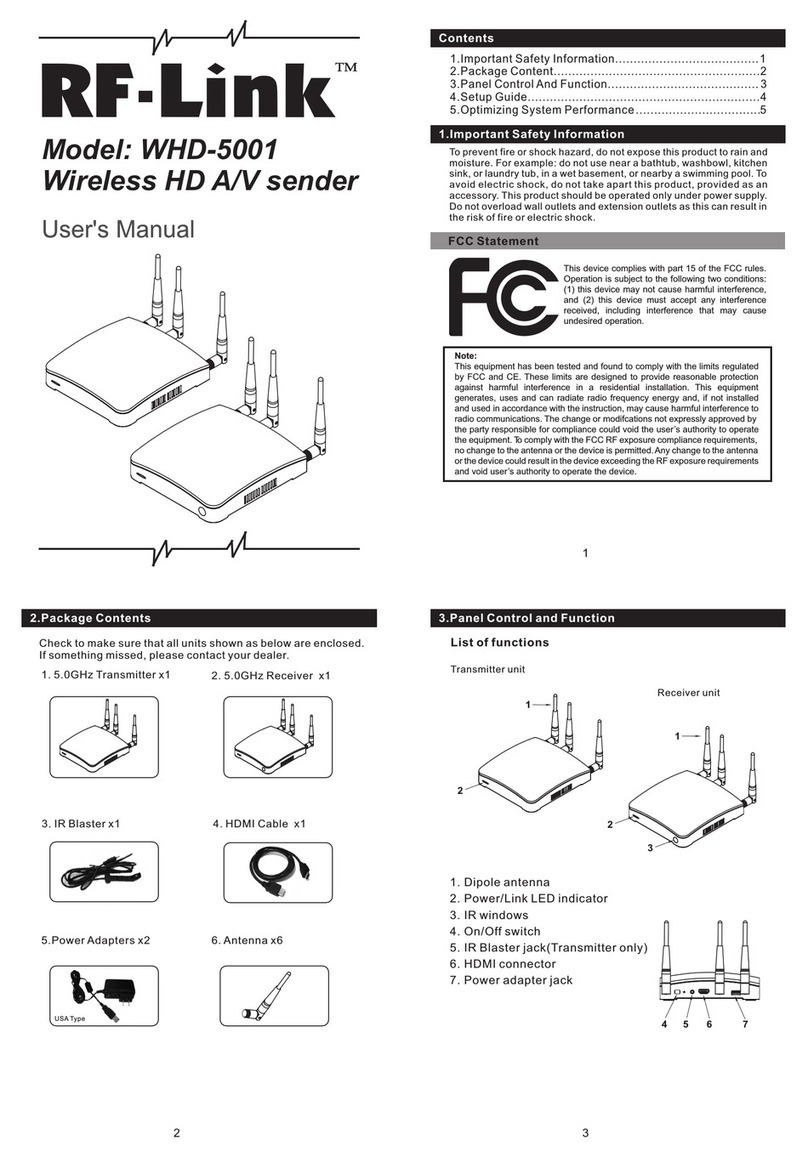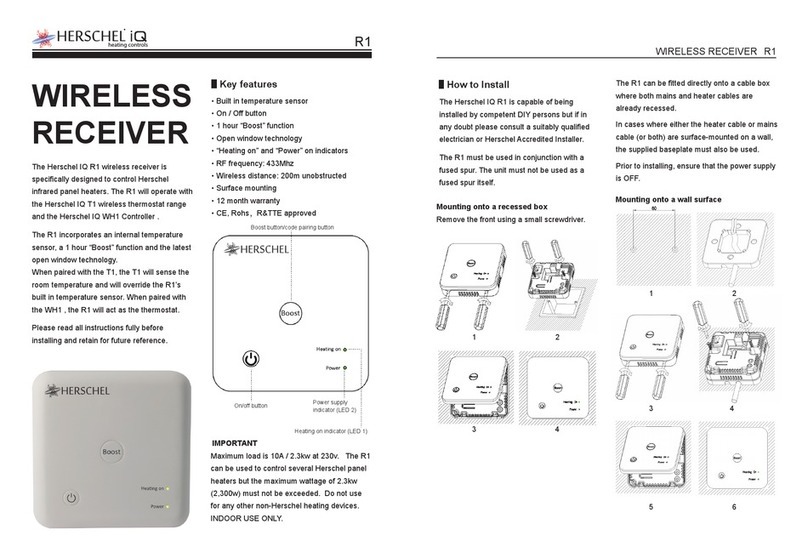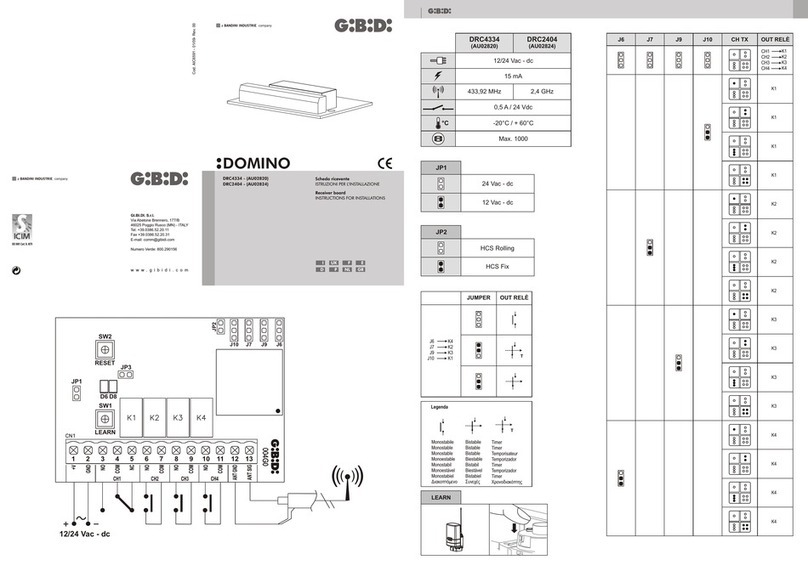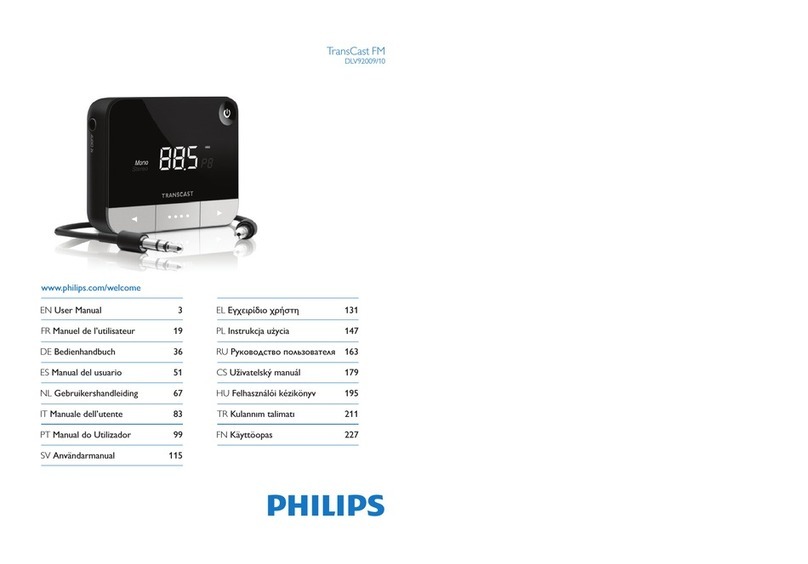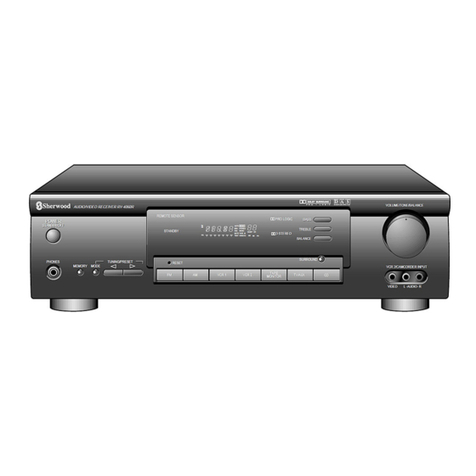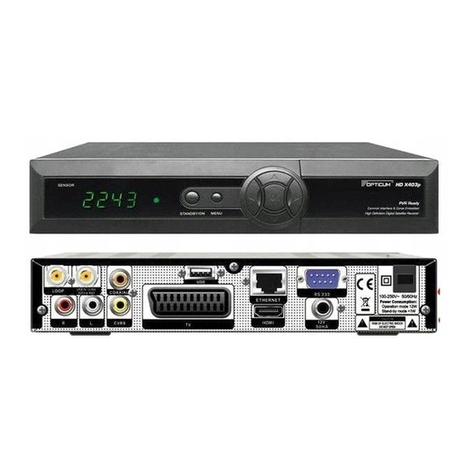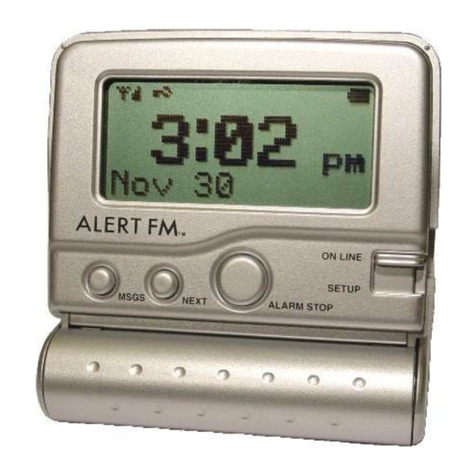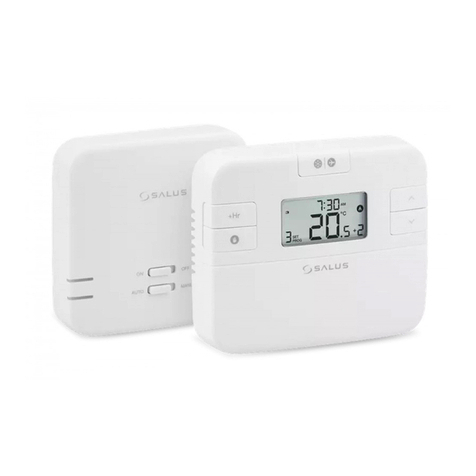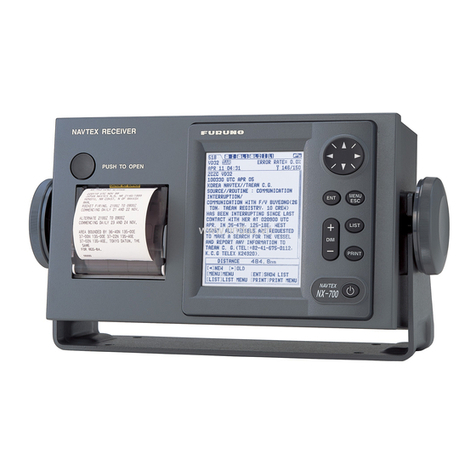Yaesu FT-1000 User manual

FT-1000
OPERATING
MANUAL
YAESU
MUSEN
CO.,
LTD.
C.P.0.BOX
1500,
TOKYO,
JAPAN
YAESU
U.S.A.
17210
Edwards
Rd.
Cerritos,
California,
90701
U.S.A.
YAESU
EUROPE
B.V.
Snipweg
3.
1118AA
Schiphol
The
NETHERLANDS

FT-1000
Operating
Manual
Errata
&
Addendum
External
ALC
Voltage
On
page
19,
in
the
description
of
the
EXT
ALC
Phono
Jack
(Item
12),
the
range
of
the
voltage
to
be
provided
by
a
linear
amplifier
to
reduce
excitation
is
shown
with
the
wrong
polarity:
the
correct
range
is
0
to
-4V.
CAT
System
Addendum
for
Revision
6.0+
EPROM
To
improve
the
versatility
of
external
com-
puter
control
of
the
FT-1000,
a
facility
to
read
back
only
the
current
memory
number,
or
a
16-byte
block
of
VFO
or
specified
memory
parameters
has
been
added
to
EPROM
Q5003
on
the
Control
Unit,
from
revision
6.0.
The
installed
EPROM
revision
number
can
be
non-destructively
checked
by
holding
the
1
and
3
keys
at
the
upper
corners
of
the
key-
pad
while
switching
on.
The
revision
number
appears
after
the
display
test
and
manufac-
turer
ID
display.
If
your
revision
is
below
6.0,
contact
your
Yaesu
dealer
for
availability
and
price
of
the
upgrade.
Revision
6.0
EPROM
firmware
adds
two
optional
parameter
bytes
(#’s
1
and
4)
to
the
Update
command:
Parameter
Byte
1
selects
the
type
(and
quantity)
of
data
to
be
returned
by
the
transceiver,
and
Parameter
Byte
4
specifies,
when
necessary,
which
memory
to
read.
This
table
indicates
the
possible
pa-
rameter
values,
and
what
they
do:
same
as
,
Current
or
Apel
aa
Last-Selected
Memor
16-Byte
structure
for
P1=2
Current
Operation
‘either
a
VFO
or
Mem)|
See
the
Table
Two
16-Byte
on
page
38
of
structures
(32
bytes)
|
the
Operating
for
Main
&
Sub
VFOs
Manual
Pi=4
and
|16-Byte
structure
for
P4=1
~
63h_|memory
number
P4
Table
Notes:
¢
Software
written
for
previous
firmware
revi-
sions
may
not
be
compatible
with
revision
6
and
later
(if
the
Update
command
is
sent
with
non-zero
parameters).
Such
software
can
be
made
compatible
simply
by
zeroing
the
Update
command
parameters.
e
Parameter
Byte
4
is
significant
only
when
requesting
memory
data
(with
Parameter
Byte
1
=
4).
Otherwise,
Parameter
Byte
4
is
ignored
by
the
transceiver.
Note
to
Programmers:
Yaesu
models
FT-1000,
FT-990
and
FT-890
all
use
similar,
although
not
identical,
pro-
-
gramming
interface
commands.
All
of
these
models
share
the
Read
Flags
command
(OFAh),
which
returns
5
bytes,
the
last
two
of
which
may
be
used
to
uniquely
identify
the
transceiver
model:
“Read
Flags”
Model
Update
Bytes
4
and
5
FT-1000
10h
00h
FT-990
09h
90h
FT-890
08h
41h
Y
YAESU
E2710101(204w-
0K)

I,
General
Information
-
General
Description
General
Description
The
FI-1000
is
a
high
performance
hf
transceiver
providing
dual-channel
reception
on
all
frequencies
between
100
kHz
and
30
MHz,
adjustable
transmitter
power
output
of
up
to
200
watts
on
all
hf
amateur
radio
bands
in
CW,
SSB,
FM,
RTTY
and
Packet
(F1
and
F2)
modes,
and
up
to
50
watts
carrier
in
AM
mode.
A
heavy-duty
AC
power
supply,
automatic
antenna
tuner
and
iambic
electronic
speed
keyer/bug
simulator
are
supplied,.
built
in,
as
standard
accessories,
along
with
eight
IF
filters
for
the
2nd
and
3rd
IFs
of
the
main
and
sub
receivers.
Inside
the
FT-1000,
modular
construction
with
ex-
tensive
use
of
surface
mount
components
on
composite
epoxy
boards
allows
greater
RF
circuit
isolation
and
higher
reliability
than
previous
manufacturing
techni-
ques.
A
squirrel
cage
blower
in
the
heart
of
the
trans-
ceiver
replaces
the
usual
rotary
fan
to
cool
the
interdigital
final
heatsinks
quietly
and
efficiently.
For
exceptionally
clean
receiver
and
transmitter
performance,
the
FT-1000
incorporates
two
10-bit
and
three
8-bit
Direct
Digital
Synthesizers
for
its
local
oscillators
(all
driven
by
a
single
TCXO
master
oscil-
lator),
and
the
operator’s
choice
of
front
end
RF
ampli-
fication
(using
four
FETs
in
a
double
push-pull,
constant-gain
stage),
direct
feed
to
the
double-balanced
quad
FET
ring
mixer,
or
three
levels
of
RF
attenuation
in
6-dB
steps.
Two
receiver
front
ends,
IF
strips
and
vfos
allow
simultaneous
reception
and
display
of
two
different
frequencies,
even
in
different
modes
and
with
different
IF
bandwidths.
Receiver
audio
can
be
com-
pletely
or
partially
mixed,
or
monitored
separately
in
each
ear.
With
independent
bandwidth
and
mode
selec-
tion
for
each
receiver,
plus
an
option
for
separate
anten-
nas
and
bandpass
filters,
a
variety
of
diversity
reception
modes
are
available
when
both
vfos
are
tuned
to
the
same
frequency.
Six
microprocessors
in
the
FT-1000
are
program-
med
to
provide
the
simplest
possible
control
interface
for
the
operator,
even
for
previously
complex
applica-
tions
like
diversity
reception
and
hf
packet.
Two
dual-
speed
tuning
knobs
allow
simple
independent
adjust-
ment
of
the
two
yfos
at
all
times.
Fine
tailoring
of
the
IF
passband
is
made
possible
with
pushbutton
crystal
filter
selection,
concentric
IF
width
and
shift
controls,
and
an
IF
notch
filter.
Separate
keys
are
also
provided
for
band
selection,
and
each
band
key
accesses
two
subband
yfo
frequency/mode/filter
settings
per
band,
so
you
can
keep
separate
vfo
settings
for
two
different
parts
of
the
band,
on
all
bands.
In
addition,
99
scanable
memories
are
provided,
each
of
which
stores
its
own
mode
and
IF
filter
selection,
in
addition
to
frequency,
clarifier
offset
and
scan
status.
The
built-in
automatic
antenna
tuner
includes
39
memories
of
its
own,
auto-
matically
storing
antenna
matching
settings
for
quick
automatic
recall
later.
Of
course
the
front
panel
keypad
can
also
be
used
to
key
in
operating
frequencies
direct-
ly,
Special
installable
options
for
the
FT-1000
include
the
BPF-1
Bandpass
Filter
Module
to
allow
dual
recep-
tion
on
separate
antennas
(and
any
hf
frequencies),
the
TCXO-1
Temperature
Controlled
Crystal
Oscillator
module
for
precision
stability
over
an
expanded
tem-
perature
range,
and
of
course
a
wide
selection
of
IF
filters
to
complement
the
eight
already
installed
as
standard,
External
options
include
the
DVS-2
Digital
Voice
Synthesizer
for
continuous
recording
and
instant
playback
of
received
signals,
and
pushbutton
pre-
recorded
transmissions;
the
SP-5
External
Loudspeak-
er
with
audio
filters
and
optional
LL-5
Phone
Patch
module;
the
YH-77ST
Stereo
Headset;
and
the
MD-
Icg
Desktop
Microphone
and
MH-1pg
Hand
Micro-
phone.
Before
connecting
the
power
cord,
you
should
read
the
Installation
section
carefully,
heeding
the
warnings
in
that
section
to
avoid
damage
to
the
set.
After
instal-
lation,
please
take
time
to
work
through
the
Operation
chapter,
referring
to
the
Controls
&
Connectors
chapter
as
necessary
for
details.
These
chapters
are
intended
to
be
read
while
sitting
in
front
of
the
FT-1000,
so
you
can
try
out
each
control
and
function
as
they
are
described.
page
I

I.
General
Information
-
Specifications
0
SSA
$7
rete
aS
6
SE
ES
Specifications
General
Receiving
frequency
range:
100
kHz
—
30
MHz
Transmitting
frequency
ranges:
160-m
band,
1.5
to
2.0
MHz
80-m
band,
3.5
to
4.0
MHz
40-m
band,
7.0
to
7.5
MHz
30-m
band,
10.0
to
10,5
MHz
20-m
band,
14.0
to
14.5
MHz
17-m
band,
18.0
to
18.5
MHz
15-m
band,
21.0
to
21.5
MHz
12-m
band,
24.5
to
25.0
MHz
LO-m
band,
28.0
to
29.7
MHz
Frequency
accuracy:
<
+
0.5
ppm
at
room
temperature
Frequency
stability:
<+
2
ppm
from
0
to
+50°C
(except
FM,
<+
200
Hz),
<+0.5
ppm
from
-10
to
+60°C
w/TCXO-1
option
(FM
<+
150
Hz
from
0
to
+50°C)
Emission
modes:
LSB/USB
(J3E),
CW
(A1A),
FSK
(J1D,
J2D),
AM
(A3B),
FM
(F3E)
Basic
frequency
steps:
10
Hz
for
J3E,
AlA
and
J1D;
100
Hz
for
A3E,
F3E
and
J2D
Antenna
impedance:
16.5
to
150Q,
50Q
nominal
Supply
voltage:
100,
110,
117,
200,
220
or
234
VAC,
50/60
Hz
Power
consumption
(approx.):
95
VA
receive,
1050
VA
for
200
watts
transmit
Dimensions
(WHD):
420
x
150
x
375
mm
Weight
(approx.):
25.5
kg.
(51
lbs)
Transmitter
Power
output:
adjustable
up
to
200
watts
(50
watts
AM
carrier)
Duty
cycle:
100%
@
100
watts,
50%
@
200
watts
(FM
&
RTTY,
3-minute
tx)
Modulation
types
SSB:
Balanced,
filtered
carrier
AM:
Low-level
(early
stage)
FM:
Variable
reactance
FSK:
Audio
frequency
shift
keying
Maximum
FM
deviation:
+
2.5
kHz
FSK
shift
frequencies:
170,425
and
850
Hz
Packet
shift
frequencies:
200,
1000
Hz
Harmonic
radiation;
at
least
50
dB
below
peak
output
SSB
carrier
suppresion:
at
least
40
dB
below
peak
output
Undesired
sideband
suppresion:
at
least
50
dB
below
peak
output
Audio
response
(SSB):
not
more
than
—6
dB
from
400
to
2600
Hz
page
2
3rd-order
IMD:
—36
dB
@
150
watts
PEP,
~—31
dB
@
200
watts
PEP,
or
better
Microphone
impedance:
500
to
600
Q
Receiver
Circuit
type:
quad-conversion
superheterodyne
(triple
conversion
for
FM)
Intermediate
frequencies:
73.62
and
8.215
MHz,
and
455
and
100
kHz
Sensitivity:
(With
preamp
on,
for
10
dB
S/N,
0
dBu
=
1
pV)
Frequency
=>
250-500
|
05-18
|
18-30
Mode
(BW)
kHz
MHz
MHz
oe
eee
29-MHz
FM
(for
12
dB
SINAD}
Selectivity
(-6/-60
dB):
Dynamic
range
(typical):
108
dB
(@50
kHz,
500-Hz
BW,
RF
amp
off)
Squelch
sensitivity:
1.8
—
30
MHz
(CW,
SSB,
AM):
<
2.0
pV
28
—
30
MHz
(FM):
<0.32
LV
IF
rejection
(1.8
—
30
MHz):
80
dB
or
better
Image
rejection
(1.8
—
30
MHz):
80
dB
or
better
IF
shift
range:
+1.12
kHz
Maximum
audio
power
output:
2
watts
into
4Q
with
<10%
THD
Audio
output
impedance:
4
to
80
Specifications
are
subject
to
change,
in
the
inter-
est
of
technical
improvement,
without
notice
or
obligation.

1.
General
Information
-
Accessories
&
Options
Accessories
&
Options
Supplied
Accessories
@
AC
Cord
9017780
l
®
'4-inch,
2-contact
Plus
C107
0090034
ad
@
Spare
Fuses
®@
RCA
Pius
___
BA
(0000039)
or
15A
(Q0000008
2
|
-1447
—
(PO0S0544)
eo
*
*
ap”
>
¥
ca
‘
®@
';-inch,
3-contact
Plug
:
@
4-pin
DIN
Plug
S-H3606
__(PO030008:
E4-7018-
00
(P0090724)
|
@
'-inch,
3-contact
Piug
7
@
5-pin
DIN
Plug
C110
(P0090726)
|
__E5-701B-00__
(P0090725)
]
Options
BPF-1
Bandpass
Filter
Module
Consisting
of
11
receiver
bandpass
filters
and
its
own
switchable
attenuator
network,
the
BPF-1
allows
the
sub
receiver
in
the
FT-1000
to
be
tuned
to
any
frequency
independently
from
the
main
receiver,
using
4
separate
antenna.
The
attenuator
control
on
the
BPF-1
can
be
used
either
to
control
sub
receiver
attenuation
separately
from
the
main
receiver,
or
be
overridden
so
that
the
FT-1000
front
panel
attenuator
knob
controls
BPF-|
both
receivers’
attenuators
in
parallel.
TCXO-I
High
Stability
Master
Reference
Oscillator
For
special
applications
and
environments
where
extra
frequency
stability
is
essential,
such
as
for
long-
term
hf
packet
monitoring
under
wide
temperature
variations,
the
TCXO-1
provides
+0.5-ppm
stability
from
—10
to
+60°C
for
the
master
reference
oscillator.
TCXO-|
page
3

1,
General
Information
-
Accessories
&
Options
MD-Ics
Desk-Top
Microphone
Designed
especially
to
match
the
electrical
and
cos-
metic
features
of
the
FT-1000,
the
MD-Icg
has
600-Q
impedance,
and
includes
up/down
scanning
buttons
and
a
large
PTT
switch
with
latch.
SP-5
Loudspeaker
with
Audio
Filters
and
LL-5
Phone
Patch
Option
Selectable
audio
high-
and
lowpass
filters
together
with
a
large
loudspeaker
complement
the
superb
audio
characteristics
of
the
FT-1000
with
your
choice
of
12
different
audio
filtering
combinations.
Two
input
ter-
minals
are
provided
for
multiple
transceivers,
with
a
front
panel
switch
to
select
between
them.
A
(mon-
aural)
phone
jack
is
provided
on
the
front
panel
to
take
advantage
of
the
audio
filters
with
headphones.
With
the
optional
LL-5
Phone
Patch
Unit
installed
in
the
SP-S,
the
FT-1000
can
be
patched
to
the
public
telephone
network.
The
LL-5
includes
a
hybrid
trans-
former
circuit
to
assure
proper
impedance
matches,
and
front
panel
gain
controls
and
level
meter
to
set
proper
audio
levels
on
the
telephone
line.
YH-77ST
Lightweight
Stereo
Headphones
Dual
samarium-cobalt
transducers
with
sensitivity
of
103dB/mW
(+2dB,
@1
kHz,
35Q)
provide
the
per-
fect
match
for
the
FT-1000.
During
dual
receive
with
the:
YH-77ST,
one
receiver
can
be
monitored
in
each
ear,
allowing
easy
separation
of
the
signals
from
the
two
receivers
(or
the
audio
can
be
mixed,
if
desired).
DVS-2
Digital
Voice
System
Serving
as
either
a
continuous
receiver
recorder
for
instant
pushbutton
playback,
or
microphone
audio
re-
corder
for
multiple
on
air
playback,
the
DVS-2
applies
the
advantages
of
random-access
solid-state
digital
memory
to
serious
communications.
All
data
is
stored
electronically,
with
no
moving
parts
except
your
finger
and
the
pushbutton.
More
information
is
on
page
33.
FIF-232C
CAT
System
Interface
To
control
the
FT-1000
from
an
RS-232C
serial
port
of
an
external
personal
computer,
use
the
FIF-232C
to
convert
the
TTL
levels
required
by
the
transceiver
to
the
RS-232C
levels
required
by
the
serial
port.
A
cable
is
included
for
connection
between
the
transceiver
and
the
FIF-232C
(the
cable
to
the
computer
must
be
pro-
vided
separately).
The
FIF-232C
includes
its
own
AC
power
supply.
DVS-2
e&
IF
Crystal
Filter
IF
Crystal
Filter
Options
Five
crystal
filters
may
be
installed
in
the
455-kHz
3rd
IFs
of
the
FT-1000,
to
function
in
cascade
with
the
eight
installed
at
the
factory.
XF-C
(XF-455K-262-01)
Main
receiver
2.4-kHz
BW
(for
all
modes
except
FM)
XF-D
(XF-455K-202-01)
Main
receiver
2.0-kHz
BW
(for
all
except
AM
&
FM)
XF-E
(XF-455K-501-01)
Main
receiver
500-Hz
BW
(for
CW,
RTTY
&
Packet)
XF-F
(XF-455K-251-01)
Main
receiver
250-Hz
BW
(for
CW
&
RTTY)
XF-455MC
Sub
receiver
600-Hz
BW
(for
CW
only)
pege
$$
—$RK$
<<
————

2.
Station
Installation
-
General
Setup
&
AC
Power
pe
EEN
ES
end
a
ee
General
Setup
&
AC
Power
Preliminary
Inspection
Inspect
the
transceiver
thoroughly
immediately
upon
opening
the
packing
carton.
Check
to
see
that
all
controls
and
switches
work
freely,
and
inspect
the
cab-
inet
for
any
signs
of
damage.
Make
sure
the
accessory
fuses
and
plugs
pictured
on
page
3
are
included.
If
any
damage
is
found
document
it
completely,
and
contact
the
shipping
company
(or
dealer,
if
you
purchased
it
over
the
counter)
right
away.
Save
the
packing
mat-
erials
in
case
you
need
to
return
the
set
for
service.
If
you
have
purchased
optional
internal
accessories
separately,
install
them
as
described
in
Chapter
6
(page
40).
Power
Connection
The
FT-1000
is
designed
for
operation
from
AC
voltage
only.
Before
connecting
power,
check
the
label
on
the
rear
panel
which
indicates
the
AC
mains
voltage
for
which
your
transceiver
is
currently
set.
If
the
volt-
age
on
this
label
does
not
match
your
AC
mains
volt-
age,
the
taps
on
the
primary
of
the
power
transformer
in
the
transceiver
must
be
rewired,
and
the
fuse
may
have
to
be
changed.
This
requires
only
a
screwdriver
and
is
not
difficult
(see
below),
but
you
should
make
sure
the
transformer
is
wired
correctly
before
connect-
ing
power.
If
you
have
any
doubts
about
the
procedure,
contact
your
dealer
for
assistance.
CAUTION
Permanent
damage
will
result
if
improper
AC
supply
voltage
is
applied
to
the
transceiver.
your
warranty
does
not
cover
damage
caused
by
application
of
improper
supply
voltage,
or
use
of
an
improper
fuse.
We
also
recommend
that
you
open
the
fuse
holder
on
the
rear
panel,
and
make
sure
that
the
fuse
is
correct
for
your
mains
voltage:
AC
Mains
Voltage
Fuse
Capacity
100,
110
or
117
15A
200,
220
or
234
8A
After
making
certain
the
AC
voltage
for
which
the
transceiver
is
set
matches
your
mains
voltage,
and
that
the
correct
fuse
is
installed
in
the
fuse
holder,
connect
the
AC
power
cord
to
the
3-pin
AC
jack
on
the
rear
panel.
Wait
until
all
other
transceiver
interconnections
have
been
made
before
connecting
the
other
end
of
the
power
cord
to
the
wall
outlet
.
Changing
the
Power
Transformer
Primary
Winding
for
Different
AC
Voltages
*
Make
certain
that
all
cables
are
disconnected
from
the
transceiver.
*
Remove
the
three
screws
from
each
side
of
the
transceiver,
and
two
from
the
top
edge
of
the
rear
panel,
Remove
the
top
cover.
*
On
the
left
side
of
the
power
transformer,
locate
the
clear
plastic
insulating
cover
with
voltage
markings.
Remove
the
four
screws
affixing
this
plate,
and
remove
it
and
the
plastic
sheet
underneath.
*
AC
from
the
power
cable
is
provided
by
the
grey
and
white
wires
connected
to
the
lower
row
of
terminals,
and
for
voltages
of
117
V
and
below,
two
jumpers
are
also
used.
Reconnect
these
wires
for
the
desired
voltage
according
to
the
diagram
at
the
right.
Do
not,
under
any
circumstances,
change
the
wiring
of
the
upper
row
of
terminals.
*
Replace
the
insulating
sheets
and
their
four
screws,
and
the
top
cover
and
its
eight
screws.
-
p>
_____
oA
L0V.
100V
-
net
ad
——e
o2
-
od
-
=
.
-~-c
*%
TTL
1000
iS
ea
“SITE
ser
re
|
“Tv
ACIOOV
ACLIOV
IMPORTANT!
If
you
change
the
primary
transformer
taps,
make
sure
to
also
change
the
voltage
marking
on
the
label
on
the
rear
panel
to
match
the
new
voltage
setting.
Also,
if
you
change
the
trans-
former
taps
for
operation
from
117V
or
below
to
220V
or
above,
or
vice-versa,
you
must
change
the
fuse
in
the
fuse
holder,
as
indicated
in
text
above.
Do
not
use
slow-blow
type
fuses.
Page
5

2.
Station
Installation
-
General
Setup
&
AC
Power
Transceiver
Location
To
assure
long
life
of
the
components,
a
primary
consideration
in
setting
up
the
FT-
1000
is
providing
for
adequate
ventilation
around
the
cabinet.
The
cooling
system
of
the
FT-1000
must
be
free
to
draw
cool
air
in
at
the
lower
rear
of
the
transceiver,
and
to
expel
warm
air
out
of
the
upper
rear
panel.
Do
not
place
the
trans-
ceiver
on
top
of
another
heat-generating
device
such
as
a
linear
amplifier,
and
do
not
place
equipment,
books
or
papers
on
top
of
the
transceiver.
Also,
provide
a
few
centimeters
of
space
on
either
side
of
the
transceiver,
if
possible.
Avoid
heating
vents
and
window
locations
that
could
expose
the
transceiver
to
excessive
direct
sunlight,
especially
in
hot
climates.
Grounding
For
protection
from
shock
and
proper
performance,
connect
the
GND
terminal
on
the
rear
panel
to
a
good
earth
ground,
using
a
heavy
braided
cable
of
the
short-
est
length
possible.
All
other
station
equipment
should
be
connected
to
the
same
grounding
cable,
as
close
together
as
practical.
If
you
use
a
computer
with
or
near
the
FT-1000,
you
may
need
to
experiment
with
ground
wiring
to
suppress
computer
noise
in
the
receiver,
Adjusting
the
Front
Feet
The
two
front
feet
of
the
FT-
1000
can
be
set
in
either
of
two
positions.
By
turning
the
knurled
ring
around
a
(retracted)
foot
clockwise,
the
middle
of
the
foot
will
extend
about
one
centimeter
.
Turn
the
ring
as
far
as
it
will
go
(about
1/4-turn)
to
lock
the
extended
foot
in
place.
To
retract
an
extended
foot,
turn
the
knurled
ring
counterclockwise
!/4-turn
while
pressing
on
the
center
of
the
foot.
Adjusting
the
Front
Feet
Antenna
Considerations
Any
antennas
connected
to
the
FT-1000
should
have
coaxial
feedlines
with
50-Q
impedance,
and
in-
clude
a
well-grounded
lightning
arrestor,
For
the
anten-
na
connected
to
the
main
ANT
jack,
the
automatic
anten-
na
tuner
in
the
FT-1000
is
capable
of
matching
antennas
with
an
SWR
of
up
to
3:1
or
more
on
the
amateur
bands
to
the
transmitter.
Nevertheless,
op-
timum
performance
for
both
reception
and
transmis-
sion
will
generally
result
with
an
antenna
designed
to
provide
a
50-Q
unbalanced
resistive
load
at
the
operat-
ing
frequency.
An
antenna
that
is
not
designed
for
resonance
at
the
operating
frequency
may
present
too
high
an
SWR
to
allow
proper
matching
with
the
built-in
antenna
tuner,
in
which
case
the
antenna
itself
should
be
readjusted,
or
an
outboard
antenna
tuner
used.
If
the
tuner
is
unable
to
bring
the
SWR
down
to
an
acceptable
level,
attempting
to
transmit
will
result
in
an
automatic
reduction
in
power
output
and
increased
losses
in
the
feedline.
Operation
under
such
conditions
is
not
re-
commended:
it
is
better
to
install
another
antenna
de-
signed
for
that
band.
Also,
if
your
antenna
has
a
balanced
feedpoint
and
you
use
a
balanced
feedline,
install
a
balun
between
the
feedline
and
the
ANT
jack
of
the
transceiver,
The
same
precautions
apply
to
any
additional
(re-
ceive-only)
antennas
connected
to
the
RX
ANT
jack,
or
to
the
BPF-1
(if
installed),
except
that
neither
of
these
antennas
will
have
the
benefit
of
the
built-in
antenna
tuner.
Therefore,
unless
such
receive-only
antennas
have
an
impedance
near
50
Q
at
the
operating
frequen-
cy,
you
may
need
to
install
an
external
antenna
tuner
to
obtain
optimum
performance.
Interconnection
of
Accessories
The
diagrams
on
the
following
pages
show
inter-
connections
of
various
external
accessories,
If
you
have
any
questions
on
these
accessories
or
connecting
devices
not
shown,
contact
your
dealer
for
advice.
Memory
Backup
The
lithium
memory
BACKUP
switch
inside
the
top
access
panel
is
turned
on
at
the
factory,
allowing
vfo
and
memory
data
to
be
retained
while
power
is
off.
Backup
current
is
miniscule,
so
it
is
not
necessary
to
turn
the
BACKUP
switch
off
unless
the
transceiver
is
to
be
stored
for
an
extended
period.
After
five
or
more
years
of
operation
the
transceiver
may
fail
to
retain
memories,
at
which
time
the
lithium
battery
should
be
replaced.
Contact
your
dealer
for
replacement
of
the
battery,
or
for
instructions
on
how
to
do
so
yourself.
pege
6
—_—__—KARA——————
——_—_
i

2.
Station
Installation
-
Connector
Pinouts
Connector
Pinouts
MIC
PHONES
1)
UP
2.
GND
3
DWN
4
FAST
GND
6)
PTT
7)
GNO
a)
MIC
ao
4)
(ae)
len)
“@
SIGNAL
(R)
>
“a
|
GND
SIGNAL
(lL
COMMON
,
_Keyer
Poddle
EXT
SPKR
SIGNAL
(SUB)
SIGNAL
(MAIN)
1)
SHIFT
2
RX
OUT
~
4)|@
PTT
4
GND
PACKET
SIGNAL
DATA
IN
GND:
PTT
DATA
OUT
BUSY
3
GND
SERIAL
OUT
SERIAL
IN
PTT
S/PO
NC
ao
ie
(m
c
he)
—
SD
of
w@
IN
—
'
VOICE
OUT
VOICE
IN
PTT
+9V
CNTL1
CNTL
2
GND
+13V
5
2)
TX
GND
3)
GND
4
BAND
DATA
A
5
BAND
DATA
B
f)
§)
BAND
DATA
C
8
7)
BAND
DATA
D
U
LINEAR
SIGNAL
or
page
7

2.
Station
Installation
-
Connecting
External
Accessories
Connecting
External
Accessories
OFF
ATT
cme
ATT
@
®
as
ON
Be
FL-7000
200
0;°°
‘come
EXT
ALC
|AC
SUPPLIED
CABLE
B
(T9!01296)
OPTIONAL
CABLE
(D400019)
SUPPLIED
CABLE
A
(T9100980)
TELEPHONE
LINE
F
T-!|O00
(x2
<
(i
i)
|
See
Ox
5)
SUPPLIED
CABLE
A
(T9101
407)
SUPPLIED
CABLE
B
(T9101
280A)
page
&

a
2.
Station
Installation
-
Internal
Settings
ee
ee
ee
Internal
Settings
Described
here
are
a
few
internal
settings
you
may
wish
to
make,
as
you
become
familiar
with
the
FT-
1000,
to
tailor
it
to
your
particular
station
require-
ments.
Be
careful,
however,
to
avoid
tampering
with
other
internal
controls,
so
as
not
to
degrade
alignment.
A
few
other
internal
controls
are
mentioned
in
the
Controls
&
Connectors
chapter.
For
full
alignment
details
covering
all
internal
controls,
refer
to
the
FT-
1000
Technical
Manual.
Key
Beeper
Volume
This
trimmer
potentiometer
sets
the
volume
(rela-
tive
to
receiver
signal
volume
as
set
by
the
AF
control)
of
the
beep
that
sounds
when
one
of
the
front
panel
buttons
is
pressed.
CAUTION
This
adjustment
must
be
made
with
power
applied,
and
with
the
cover
removed.
Although
the
voltages
at
exposed
places
in
the
trans-
ceiver
are
not
dangerous
to
you,
sensitive
cir-
cuitry
can
be
damaged
by
contact
with
metallic
tools.
Therefore
we
recommend
using
a
non-
metallic
adjustment
tool,
if
available.
In
any
case,
avoid
touching
any
components
not
in-
volved
in
the
adjustment,
and
do
not
allow
anything
to
fall
in
the
set
while
the
cover
is
removed.
¢
Disconnect
the
cables
from
the
transceiver,
and
turn
the
set
upside-down
on
the
table.
eo
(=
ww
*
Remove
the
ten
screws
shown
below,
and
remove
the
bottom
cover.
*
Now
place
the
set
on
its
side,
reconnect
the
AC
power
cable
and
antenna.
¢
Turn
the
transceiver
on,
and
adjust
the
AF
control
for
normal
volume
on
background
noise
on
a
common-
ly-used
band,
*
Locate
VR3007
from
the
photo
below,
and
use
a
small
screwdriver
to
adjust
it
for
the
desired
beep
volume
while
repeately
pressing
a
front
panel
key.
*
Switch
the
transceiver
off,
disconnect
the
power
cable,
turn the
transceiver
on
its
top
again,
and
re-
place
the
bottom
cover
and
ten
screws
removed
above
(unless
also
setting
$1001,
as
described
next).
RX
ANT
Switch
Selection
Setting
with
BPF-1
Option
(RF
Unit
Switch
$1001)
As
supplied
from
the
factory,
the
RX
ANT
switch
on
the
front
panel
is
configured
to
select
a
separate
receive-only
antenna
connected
to
the
RX
ANT
jack
on
the
rear
panel.
If
the
BPF-1
Bandpass
Filter
Option
is
installed,
this
switch
can
be
reconfigured
to
select
the
SUB
RX
ANT
jack
on
the
BPF-1
instead,
by
resetting
switch
§1001
on
the
RF
Unit.
Note
however,
that
set-
ting
this
switch
to
the
E
BPF
position
disables
the
capability
of
operating
split-frequency
with
a
separate
receive
antenna
(see
the
schematics
on
page
29).
To
gain
access
to
the
RF
Unit,
remove
the
ten
screws
shown
in
the
photo
at
the
lower
left,
and
remove
the
bottom
cover.
$1001
is
located
near
the
back
left
corner,
as
shown
below.
page
9

3.
Controls
&
Connectors
-
Front
Panel
Controls
Front
Panel
Controls
This
chapter
describes
each
control
and
connector
on
the
FT-1000.
You
can
just
read
through
quickly
now,
but
some
of
the
descriptions
will
be
more
meaningful
if
you
first
work
through
the
Getting
Started
Tutorial
at
the
beginning
of
the
Operating
chapter,
and
then
return
to
this
chapter
with
the
set
powered
up,
as
questions
arise
during
operation.
Some
controls
and
switches
are
disabled
under
certain
conditions.
(1)
POWER
This
button
turns
the
transceiver
on
and
off.
(2)
2-Position
Pushbutton
Switches
RX
ANT
When
this
switch
is
in
the
undepressed
position,
the
antenna
connected
to
the
main
ANTsocket
is
used
for
receive
(it
is
always
used
for
transmit).
When
this
switch
is
depressed
(LED
indicator
on),
a
second
an-
tenna
connected
to
the
RX
ANT
is
used
by
the
receiver(s).
If
the
BPF-1
is
installed,
this
switch
can
be
recon-
figured
to
select
the
SUB
RX
ANT
jack
on
the
BPF-1,
enabling
reception
on
two
antennas,
by
resetting
switch
$1001
on
the
RF
Unit
(see
pages
9
and
29).
MOX
This
button
may
be
used
in
place
of
a
microphone
PTT
switch
or
CW
key
to
manually
activate
the
trans-
mitter,
when
depressed.
It
must
be
in
the
undepressed
position
for
reception.
vox
Enables
automatic
voice-actuated
transmitter
swit-
ching
in
SSB,
AM
and
FM
modes;
and
semi
break-in
page
10
keying
in
CW
mode.
The
controls
affecting
VOX
oper-
ation
are
located
in
the
top
access
panel,
DIM
Dims
the
brightness
of
the
display
and
meter
lamp
for
comfortable
viewing
in
the
dark.
Display
Dim
Level
Adjustment
The
brightness
of
the
dim
selection
is
adjustable
by
holding
the
FAST
button
while
turning
the
CLAR
control.
(3)
METER
Selector
This
selector
determines
the
function
of
the
multi-
meter
during
transmission.
The
meanings
of
the
ab-
breviations
are
as
follows:
ALC
=
relative
Automatic
Level
Control
voltage
COMP
=
RF
speech
compressor
level
(in
dB,
for
SSB
modes
only)
PO
=
RF
Power
Output
(watts)
SHR
=
Standing
Wave
Ratio
(forward:reflected)
Ic
=
Final
amplifier
collector
current
(Amps)
ycc
=
Final
amplifier
collector
voltage.
The
meter
indicates
the
selected
parameter
during
transmission,
and
signal
strength
in
S-units
during
re-
ception
(on
the
main
receiver).
Each
S-unit
is
approx-
imately
6
dB.
(4)
AGC
Selector
Selects
main
receiver
Automatic
Gain
Control
de-
cay
time
for
most
comfortable
reception,
or
disables

ae
3.
Controls
&
Connectors
-
Front Panel
Controls
IR
receiver
AGC
(off).
Normally
this
switch
is
set
to
the
MED
position.
Strong
signals
will
cause
distortion
if
this
selector
is
set
to
OFF.
(5)
FRONT
END
Use
this
selector
to
set
the
optimum
receiver
front
end
characteristics.
The
NOR
position
activates
the
inter-
nal
rf
amplifier,
for
maximum
receiver
sensitivity
on
a
quiet
band.
The
IPO
position
bypasses
the
rf
amplifier
and
feeds
the
received
signals
directly
to
the
first
mixer.
The
other
positions
insert
6-,
12-
or
18-dB
(1,
2
or
3
S-units)
of
attenuation
before
the
mixer,
to
suppress
band
noise
and
possible
overload
from
very
strong
signals.
If
the
optional
BPF-1
Bandpass
Filter
Unit
is
installed,
the
functions
of
this
selector,
for
the
sub
receiver,
may
be
controlled
either
in
parallel
with
the
main
receiver
via
this
selector,
or
independently
via the
selector
on
the
BPF-1,
(6)
RX
MIX
~@>
MONI
The
inner
RX
MIX
control
adjusts
the
relative
balance
of
receiver
audio
between
the
two
receiver
channels
during
dual
reception.
The
outer
MONI
control
adjusts
the
audio
volume
of
the
CW
sidetone,
and
transmit
RF
monitor
during
transmission,
when
activated
by
the
gray
button
with
the
same
name.
(7)
MIC
~®>
RF
PWR
The
inner
MIC
control
adjusts
the
microphone
input
level
for
(non-processed)
SSB
and
AM
transmission.
The
outer
RF
PWR
control
adjusts
the
transmitter
output
power
in
all
modes.
The
adjustment
range
is
from
less
than
20
to
200
watts,
except
in
AM
mode,
where
it
is
from
about
5
to
50
watts.
(8)
PROC
-@~
DRIVE
The
inner
PROC
control
sets
the
compression
(input)
level
of
the
transmitter
RF
speech
processor
in
SSB
modes,
when
activated
by
the
gray
button
with
the
same
name.
The
outer
DRIVE
control
sets
the
carrier
level for
CW
and
AM
transmission.
Also,
when
the
speech
processor
is
used
in
the
SSB
modes,
this
control
sets
the
processor
level.
In
each
case,
the
ALC
function
of
the
meter
should
always
be
selected
when
setting
this
control,
to
avoid
overdriving
the
transmitter
final
amplifier.
(9)
SQL
-—®>
NB
The
inner
SQL
control
sets
the
signal
level
threshold
at
which
receiver
audio
is
muted
(and
the
green
BUSY
LEDs
turn
off),
in
all
modes.
This
control
is
normally
kept
fully
CCW,
except
when
scanning,
and
during
FM
operation.
Both
main
and
sub
receivers
are
affected.
The
outer
NB
control
adjusts
the
blanking
level
when
the
noise
blanker
is
activated
during
reception,
for
the
main
receiver.
If
set
very
far
clockwise,
receiver
audio
may
be
distorted.
(10)
AF
-<®>
RF
The
inner
AF
gain
control
adjusts
the
audio
volume
of
the
receiver(s)
in
the
speaker
or
headphones.
The
outer
RF
gain
control
adjusts
the
receiver
signal
level
in
front
of
the
main
receiver
1st
mixer
(via
PIN
diodes),
and
also
the
gain
of
the
main
receiver
IF
amplifiers.
This
control
is
normally
set
fully
clockwise
for
maximum
sensitivity.
When
rotated
counterclock-
wise
from
maximum,
the
S-meter
minimum
deflection
point
will
move
up
the
scale.
The
peak
deflection
for
a
particular
signal
will
remain
the
same
if
it
is
greater
than
the
level
set
by
this
control,
but
the
main
receiver
will
be
insensitive
to
weaker
signals.
This
control
also
affects
the
SQL
setting
for
the
main
receiver,
and
should
be
preset
fully
clockwise
when
setting
the
squelch
threshold
for
vfo
A
or
a
recalled
memory.
This
control
does
not
affect
the
sub
receiver.
(11)
MIC
This
8-pin
jack
accepts
the
MD-1pg
or
MD-Icg
Desktop
Microphone
or
the
MH-1
pg
Handie
Scanning
Microphone.
MIC
pinout
is
shown
on
page
7.
Proper
microphone
input
impedance
is
500
to
600
ohms.
(12)
KEY
This
1/4-inch,
-3-contact
jack
accepts
a
CW
key
or
keyer
paddles
(for
the
built-in
electronic
keyer),
or
output
from
an
external
electronic
keyer.
You
cannot
use
a
2-contact
plug
in
this
jack,
Pinout
is
shown
on
page
7.
Key
up
voltage
is
5
V,
and
key
down
current
is
0.5
mA.
There
is
another
jack
with
the
same
name,
connected
in
parallel
with
this
jack,
on
the
rear
panel.
(13)
PHONES
This
1/4-inch,
3-contact
jack
accepts
either
mon-
aural
or
stereo
headphones
with
a
2-
or
3-contact
plug.
When
a
plug
is
inserted,
the
loudspeaker
is
disabled.
With
stereo
headphones
such
as
the
optional
YH-77ST,
you
can
monitor
both
receiver
channels
at
the
same
time
during
dual
reception.
In
this
case,
the
PHONE
switch
(page
17)
in
the
top
access
panel
selects
mixed,
separate
or
monaural
headphone
operation.
(14)
Push
Switches
PROC
This
gray
button
enables
the
RF
speech
processor
for
SSB
transmission.
Processing
level
is
set
by
the
control
with
the
same
name.
While
activated,
the
LED
above
this
button
glows
orange.
page
Il

3;
Controls
&
Connectors
-
Front
Panel
Controls
AESU
VO
Ad
RO
foves
Star
wecan
MONT
This
gray
button
enables
the
transmit
(RF)
monitor
in
all
modes
(except
CW,
in
which
the
monitor
function
is
always
on,
to
produce
the
sidetone).
Audio
level
(relative
to
the
main
AF
control)
is
set
by
the
control
with
the
same
name.
The
LED
above
this
button
glows
orange
while
activated,
NB
&
NB-W
These
buttons
activate
the
main
receiver
noise
blankers.
Press
the
NB
button
to
blank
short
pulse
noise
such
as
from
automobile
ignitions,
power
lines
and
switching
transient
spikes.
Press
the
NB-W
button
to
blank
long
pulse
noise,
such
as
the
“Woodpecker”
over-the-horizon
radar.
The
LEDs
above
each
button
glow
green
while
activated,
Blanking
level
for
both
blankers
is
set
by
the
control
with
the
same
name.
A-B
This
button
transfers
data
from
the
main
display
(either
the
main
vfo
(A)
or
a
recalled
memory
channel)
to
the
sub
vfo
(B),
overwriting
any
previous
contents
in
the
sub
vfo.
Use
this
key
to
instantly
set
both
main
and
sub
receivers
to
the
same
frequency
and
mode.
ASB
This
button
exchanges
the
contents
of
the
main
display
(either
the
main
vfo
(A)
or
a
recalled
memory
channel),
and
sub
vfo
(B).
No
data
is
lost.
M=
VFO-A
Pressing
this
button
momentarily
displays
the
con-
tents
of
the
currently
selected
memory
channel
for
three
seconds.
Holding
this
button
for
for
!/2-second
copies
the
data
from
the
currently
selected
memory
to
the
main
vfo
(A),
as
two
beeps
sound.
Previous
data
in
the
main
vfo
is
overwritten,
RPT
When
operating
in
the
FM
mode
on
the
29-MHz
band,
this
button
activates
standard
hf
FM
repeater
operation.
Pressing
this
button
once
or
twice
while
receiving
causes
the
transmit
frequency
to
be
shifted
100
kHz
below
or
above
the
receiving
frequency,
res-
pectively.
An
88.5-Hz
subaudible
tone
is
also
trans-
mitted
automatically
at
a
low
level
when
using
this
feature,
to
allow
access
to
repeaters
that
require
it.
Pressing
this
button
a
third
time
cancels
repeater
shift
operation.
M
CK
(Memory
Check)
This
button
allows
display
of
the
contents
of
the
memory
channels
without
disturbing
operation,
When
pressed,
M
CK
is
displayed
just
above
the
channel
num-
ber.
The
contents
of
each
memory
channel
can
then
be
checked
on
the
sub
receiver
display
by
rotating
the
MEM
selector.
Empty
memory
channels
display
as
two
deci-
mals,
with
no
frequency
digits.
Press
this
button
again
to
cancel
memory
checking.
SPLIT
This
button
activates
split
frequency
operation
be-
tween
the
main
display
(either
the
main
vfo
(A)
or
a
recalled
memory
channel),
used
for
transmission,
and
the
sub
vfo
(B),
for
reception.
The
SPLIT
indicator
on
the
display
is
lit
while
this
function
is
active.
DUAL
This
button
activates
dual-channel
reception
with
the
main
and
sub
receivers.
When
this
function
is
ac-
pege
12
RaR_a__
A
AA
AA
i
_
$_
$_ $_
_

3.
Controls
&
Connectors
-
Front
Panel
Controls
tive,
DUAL
is
displayed
in
an
orange
box
at
the
left
edge
of
the
display.
DOWN
&
UP
Pressing
either
of
these
buttons
momentarily
steps
the
operating
frequency
down
or
up
100
kHz,
respec-
tively.
Pressing
and
holding
the
FAST
button
while
pressing
one
of
these
buttons
steps
down
or
up
1
MHz.
Continue
holding
either
button
for
repeated
stepping.
NOTCH
This
button
activates
the
IF
notch
filter
for
the
main
receiver.
The
frequency
of
the
notch
is
set
by
the
con-
trol
with
the
same
name.
The
LED
above
this
button
glows
green
while
the
notch
filter
is
active.
The
notch
filter
does
not
affect
the
sub
receiver.
APF
This
button
activates
the
Audio
Peak
Filter
during
CW
operation
with
the
main
receiver.
The
peak
fre-
quency
is
set
by
the
control
with
the
same
name.
The
LED
above
this
button
glows
green
while
the
audio
peak
filter
is
active.
Sub
receiver
operation
is
unaf-
fected.
VFO-A
>
M
Pressing
and
holding
this
yellow
button
for
1/2-
second
transfers
(writes)
the
current
main
operating
data
from
the
main
vfo
(A),
or
a
recalled
memory,
to
the
currently
selected
memory
channel,
overwriting
any
previous
data
stored
there.
Also,
pressing
and
hold-
ing
this
button
after
recalling
a
memory,
without
first
retuning,
causes
the
memory
channel
to
be
“blanked”,
and
repeating
the
process
restores
the
blanked
memory.
VFO/MEM
This
button
toggles
main
receiver
operation
be-
tween
the
memory
channel
and
the
main
vfo
(A).
Either
VFO,
MEM
or
M
TUNE
is
displayed
to
the
left
of
the
main
frequency
display
to
indicate
the
current
selection.
If
a
displayed
memory
has
been
retuned,
pressing
this
but-
ton
returns
the
display
to
the
original
memory
contents,
and
pressing
it
again
returns
operation
to
the
main
vfo.
(15)
MODE
These
seven
momentary
buttons
select
the
oper-
ating
mode,
indicated
by
the
LED
in
each
button.
Note
that
pressing
the
RTTY
and
PACKET
buttons
multiple
times
will
switch
between
the
possible
modes
of
emis-
sion
that
can
be
used
by
these
digital
modes
(LSB
and
USB
for
RTTY,
and
LSB
and
FM
for
packet).
(16)
FAST
For
fast
tuning,
press
and
hold
this
button
while
rotating
the
main
or
sub
tuning
knobs
or
pressing
the
UP
or
DOWN
button
to
increase
the
tuning
rate
ten
times.
See
the
table
on
page
20
for
all
available
steps.
(17)
Main
(VFO-A)
Tuning
Knob
This
knob
adjusts
the
operating
frequency
of
the
main
vfo
(A)
or
a
recalled
memory.
Tuning
increments
are
normally
10
Hz
(100
Hz
in
AM
and
FM
modes).
When
the
FAST
button
is
held,
the
increments
are
ten
times
these
sizes.
The
markings
on
the
knob
represent
50
increments
each,
and
one
full
turn
of
the
knob
provides
1,000
increments
(10
kHz,
or
100
kHz
in
AM/FM).
page
13

3.
Controls
&
Connectors
-
Front
Panel
Controls
(18)
MAIN
VFO-A
RX
&
TX
LEDs
These
lamps
indicate
the
transmit/receive
status
of
the
main
tuning
knob
and
display.
When
the
green
RX
lamp
is
lit,
the
receiving
frequency
is
under
control
of
the
main
knob
and
display
(either
vfo
(A)
or
a
recalled
memory
channel).
When
the
red
TX
lamp
is
lit,
the
transmitting
frequency
is
under
control
of
the
main
knob
and
display.
(19)
Lock
This
button
toggles
locking
of
the
main
tuning
knob
to
prevent
accidental
frequency
changes.
LOCK
is
dis-
played
in
a
red
box
above
the
main
frequency
when
active
(the
knob
can
still
be
turned,
but
it
does
nothing).
Press
again
to
re-enable
the
tuning
knob.
(20)
BANDWIDTH
These
four
momentary
buttons
select
the
2nd
and
3rd
IF
filters
for the
receiver
(except
in
the
FM
mode).
In
AM
moée,
either
2.4-kHz
or
6-kHz
bandwidths
are
selected
by
pressing
the
2.4K
button
(off
=
6-kHz).
The
selectivity
provided
by
these
selections
can
be
further
enhanced
by
installing
optional
filters
(page
40).
See
the
diagram
on
page
23
for
the
available
filter
combina-
tions.
The
sub
receiver
uses
only
500-kHz
(optional)
and
2.4-kHz
selections.
(21)
BAND
(Keypad)
The
keypad
provides
one-touch
band
selection,
or
digital
frequency
entry.
Normally,
pressing
one
of
the
ten
white
numbered
keys
selects
the
corresponding
(MHz)
amateur
band
for
operation
(and
pressing
the
SUB
button
first
and
then
another
key
selects
the
band
for
the
sub
vfo.
However,
if
the
ENT
key
is
pressed
first,
the
yellow
labels
on
the
keys
become
effective,
for
entering
any
frequency
one
digit
at
a
time.
If
you
press
the
white
numbered
key
for the
band
your
are
already
on,
you
will
select
the
alternate
subband
vfo
on
that
band.
See
the
Operation
chapter
for
details.
(22)
Sub
(VFO-B)
Tuning
Knob
This
knob
adjusts
the
sub
vfo
(B)
operating
frequen-
cy.
Tuning
increments
are
the
same
as
described
for
the
main
tuning
knob.
(23)
SUB
VFO-B
RX
&
TX
LEDs
These
lamps
indicate
the
current
status
of
the
sub
vfo.
When
the
green
RX
lamp
is
lit,
the
receiving
fre-
quency
is
under
control
of
the
sub
vfo
(B).
When
the
red
TX
lamp
is
lit,
the
transmitting
frequency
is
under
control
of
the
sub
vfo.
During
dual
receive
operation,
the
RX
lamps
above
both
tuning
knobs
are
lit.
(24)
Lock
This
button
toggles
locking
of
the
sub
vfo
tuning
to
prevent
accidental
frequency
changes.
The
red
LED
just
above
this
button
glows
when
active
(the
knob
can
still
be
turned,
but
it
does
nothing).
Press
the
button
again
to
re-enable
the
tuning
knob.
(25)
NOTCH
-@>
APF
These
controls
are
active
only
when
their
functions
have
been
enabled
by
the
corresponding
buttons
below
the
sub
vfo
tuning
knob.
The
LEDs
above
the
buttons
indicate
when
the
functions
are
active.
The
inner
NOTCH
control
adjusts
the
IF
notch
filter
frequency.
The
outer
APF
control
adjusts
the
frequency
of
the
Audio
Peak
Filter
in
CW
mode.
Both
affect
only
the
main
receiver.
(26)
CLAR
Tuning
Knob
This
knob
tunes
the
clarifier
offset
frequency
up
to
+9.99
kHz,
when
activated
by
the
CLAR
RX
and/or
TX
buttons
just
above
it
(the
3-digit
offset
frequency
ap-
pears
in
the
center
of
the
display
when
the
clarifier
is
active).
Operating
details
are
on
page
28.
(27)
SHIFT
-<@>
WIDTH
These
controls
tailor
the
IF
passband
of
the
main
receiver
(the
main
vfo
(A),
or
a
recalled
memory
chan-
nel)
in
all
modes
except
FM.
The
inner
SHIFT
control
offsets
the
center
frequency
of
the
IF
passband
from
the
displayed
frequency
when
turned
away
from
the
12-
o’clock
position.
The
outer
WIDTH
control,
when
turned
counterclockwise
from
the
fully
clockwise
position,
reduces
the
overall
IF
bandwidth
from
the
maximum
selected
by
the
BANDWIDTH
buttons.
(28)
MEM
This
detented
knob
selects
the
operating
memory
channel
when
the
memories
are
active
(but
not
re-
tuned).
When
the
vfo
or
memory
tune
functions
of
the
main
display
are
active,
turning
this
knob
causes
the
sub vfo
display
to
temporarily
show
the
frequencies
of
the
memories
(memory
check),
without
otherwise
af-
fecting
operation.
The
channel
number
of
the
selected
memory
is
displayed
at
all
times
at
the
center
right
of
the
display
(in
front
of
“CH”’).
(29)
Electronic
CW
Keyer
Controls
The
KEYER
button
toggles
the
internal
CW
keyer
on
and
off,
as
indicated
by
the
LED
above
this
button.
BK-IN
turns
full
break-in
(QSK)
CW
operation
on
and
off.
SPOT
turns
the
CW
receiver
spotting
heterodyne
oscillator
on
and
off.
The
SPEED
control
sets
the
repeti-
tion
rate
of
the
keyer/bug
simulator.
PO
eee

3.
Controls
&
Connectors
-
Front
Panel
Controls
(30)
CLAR
Pushbuttons
Pressing
the
RX
button
activates
the
CLAR
knob
(below
this
button),
to
allow
offsetting
the
receiving
frequency
temporarily
(see
(26),
above).
The
TX
button
provides
the
same
function
for
the
transmit
frequency.
If
both
buttons
are
pressed,
the
receiver
and
transmitter
are
both
offset
from
the
original
frequency.
Pressing
the
CLEAR
button
zeros
any
offset
tuned
by
the
CLAR
knob,
Each
memory
and
vfo
retains
all
clarifier
settings
inde-
pendently.
(31)
TUNER
2-Position
Pushbutton
Pressing
this
button
so
that
its
LED
is
lit
places
the
antenna
tuner
in
line
between
the
transmitter
final
amp-
lifier
and
the
main
antenna
jack.
Reception
is
not
af-
fected.
The
tuner
is
also
activated
when
the
START
button
(below)
is
pressed.
(32)
START
Momentary
Pushbutton
Pressing
this
button
while
receiving
in
an
amateur
band
activates
the
transmitter
for
a
few
seconds
while
the
automatic
antenna
tuner
rematches
the
antenna
for
minimum
SWR.
The
resulting
settings
are
automat-
ically
stored
in
one
of
the
antenna
tuner’s
39
memories,
for
instant
automatic
recall
later
when
the
receiver
is
tuned
near
the
same
frequency.
(33)
M
SCAN
Pushbutton
Activates
scanning
of
the
memory
channels.
Also
used
together
with
the
FAST
button
to
set/reset
Scan
Skip
status
of
a
recalled
memory
channel.
(34)
Right
Side
LED
Indicators
The
WI
sWwR
LED
lights
when
an
impedance
mis-
match
is
detected
at
the
main
ANT
jack.
Avoid
transmit-
ting
until
the
problem
has
been
corrected,
The
WAIT
LED
lights
while
the
antenna
tuner
is
tuning,
and
flashes
briefly
when
changing
frequency,
as
the
main
cpu
sends
new
frequency
data
to
the
anten-
na
tuner
coprocessor:
this
does
not
affect
operation.
The
CW
TUNE
LED
is
a
visual
tuning
indicator
for
CW
Teception
on
the
main
receiver,
which
lights
in
synch-
ronization
with
a
signal
tuned
to
the
center
of
the
IF
passband
during
CW
reception.
(35)
Digital
Display
The
display
shows,
from
left
to
right,
special
oper-
ating
status
(CAT
SYSTEM,
DUAL,
SPLIT
or
GEN
(eral
coverage),
VFO,
MEM
Or
M
TUNE
mode
of
the
main
receiver;
main
receiver
operating
frequency,
clarifier
offset,
memory
channel
number;
and
sub
vfo
mode
and
fre-
quency.
(36)
Left
Side
LED
Indicators
The
TRANSMIT
LED
glows
red
when
the
transmitter
is
activated.
The
MAIN BUSY
and
SUB
BUSY
LEDs
glow
green
when
the
main
or
sub
vfo
squelch
is
open,
respectively.
(37)
Meter
The
7-function
multimeter
normally
indicates
main
receiver
signal
strength
on
the
top
scale,
and
one
of
six
parameters
(selected
by
the
METER
selector)
during
transmit
on
the
lower
scales.
page
1S

3.
Controls
&
Connectors
-
Top
Access
Panel
Controls
Top
Access
Panel
Controls
PKT_RITY
(1)
VOX
GAIN
This
control
sets
the
gain
of
the
VOX
(voice-ac-
tuated
transmit/receive
switching)
circuit,
to
set
the
level
of
microphone
audio
needed
to
activate
the
trans-
mitter
during
voice
operation
while
the
VOX
button
on
the
front
panel
is
depressed,
(2)
VOX
ANTI-TRIP
This
control
sets
the
level
of
negative
feedback
of
receiver
audio
to
the
microphone,
to
prevent
receiver
audio
from
activating
the
transmitter
(via
the
micro-
phone)
during
VOX
operation.
Adjustment
is
described
in
the
Operation
chapter.
(3)
VOX
DELAY
This
control
sets
the
hang
time
of
the
VOX
circuit,
between
the
moment
you
stop
speaking
(or
open
the
CW
key
during
semi
break-in
operation)
and
the
auto-
matic
switch
from
transmit
back
to
receive
(during
VOX
operation).
Adjust
for
smooth
VOX
or
semi
break-in
operation
(so
the
receiver
is
activated
only
when
you
want
to
listen).
(4)
FM
MIC
GAIN
During
FM
operation,
this
control
adjusts
the
mic-
rophone
gain
(and
transmitter
deviation).
More
clock-
wise
settings
produce
a
wider
bandwidth
signal.
NOTE:
This
control
has
been
preset
at
the
factory
to
produce
the
correct
deviation
with
standard
micro-
phone
levels.
A
deviation
meter
should
be
connected
for
proper
readjustment,
as
it
is
difficult
to
determine
the
proper
setting
by
ear.
(5S)
WEIGHT
DIP
Switches
These
DIP
switches
select
the
weight
(dot:dash
ratio)
of
the
internal
electronic
CW
keyer,
between
1:3
page
16
and
1:4.5.
Selection
is
made
by
setting
the
switches
for
a
binary
number
between
0
and
16,
as
shown
below.
Keyer
Weight
Settings
(6)
PKT
RTTY
DIP
Switches
The
two
leftmost
switches
(1
and
2)
of
this
set
select
the
offset
of
the
display
and
IF
passband
center
from
the
BFO,
to
match
most
common
packet
tncs
used
for
300-baud
hf
packet
operation.
To
set
these
switches,
determine
which
AFSK
tones
are
used
by
your
tnc,
and
then
set
the
switches
to
match
as
shown
below.
Packet
FSK
Tone
Pairs
The
remaining
switches
in
this
set
select
the
func-
tion
of
the
internal
AFSK
generator
for
RTTY
trans-
mission.
Switches
3
and
4
select
the
RTTY
shift,
switch
5
selects
either
normal
(low
Mark)
or
reversed
tones,
and
switch
6
selects
either
a
2125-Hz
or
1275-Hz
Mark
tone.
See
the
table
below.
RTTY
DIP
Ses
|
ate
fo
||
Rv
[0
|
rete
|
0
|
|
scone
|
-
|
0
|
Nor:
LSB
Keydown
=
Mark
Tone
Rev:
LSB
Keydown
=
Space
Tone

3.
Controls
&
Connectors
-
Top
Access
Panel
Controls
(7)
Cd
PITCH
DIP
Switches
Set
these
switches
to
select
your
desired
CW
tone
pitch,
as
shown
below.
The
transmitter
sidetone
fre-
quency,
and
receiver
IF
passband
and
display
offset
from
the
BFO
(carrier)
frequency
are
all
affected.
(8)
BACKUP
Slide
Switch
Keep
this
switch
in
the
on
position
to
retain
all
memory
and
vfo
settings
during
power-off
periods,
There
is
no
need
to
turn
this
switch
off
unless
you
plan
to
store
the
transceiver
for
a
long
period
without
use.
(10)
PHONE
Slide
Switch
This
switch
selects
between
three
possible
modes
of
dual-receive
audio
when
stereo
headphones
are
con-
nected
to
the
front
pane!
PHONES
jack.
The
@ix
(mixed)
mode
is
a
combination
of
the
other
two
modes
described
below:
audio
from
both
receivers
can
be
heard
in
each
ear,
but
the
sub
receiver
audio
is
attenuated
in
the
left
ear,
and
the
main
receiver
audio
is
attenuated
in
the
right.
In
the
st
(stereo)
mode,
audio
from
the
main
recei-
ver
is
heard
only
in
the
left
ear,
and
audio
from
the
sub
receiver
is
heard
only
in
the
right
ear.
In
the
mono
(monaural)
mode,
audio
from
both
main
and
sub
receivers
is
combined
and
heard
the
same
in
both
ears
(as
from
the
loudspeaker
when
headphones
are
not
used).
Note
that
both
receivers
must
be
activated
by
the
DUAL
button
on
the
front
panel,
and
the
RX
MIX
control
on
the
front
pane]
must
be
set
near
the
center
position,
’
‘
to
hear
both
receiver
channels.
(9)
MARK
Slide
Switch
Set
this
switch
on
to
activate
the
internal
10-kHz
marker
generator,
for
testing
or
calibration
purposes.
For
normal
receiver
operation,
this
switch
must
be
off.
This
switch
does
not
affect
dual-channel
audio
from
the
AF
OUT
jack
on
the
rear
panel,
which
should
be
processed
by
an
external
stereo
amplifier.
Power
Up
Selections
By
pressing
and
holding
certain
combinations
of
keypad
keys
while
switching
on
the
FT-1000,
you can
perform
several
functions
and
make
some
simple
settings,
To
reset
the
microprocessors
and
clear
all
memories,
turn
the
transceiver
off,
and
then
press
and
hold
the
SUB
and
ENT
keys
at
the
lower
corners
of
the
keypad
while
also
pressing
the
POWER
switch.
Normally
there
should
be
no
need
to
do
this,
but
it
is
provided
for
servicing
purposes,
to
return
all
memories
and
other
settings
to
their
default
states.
Note
that
it
is
not
necessary
to
turn
off
the
memory
backup
to
reset
the
microprocessors.
To
perform
the
“Las
Vegas”
diagnostic
test
of
the
display
and
its
microprocessor,
and
to
check
the
ROM
version
of
your
transceiver,
press
and
hold
the
1.5
and
7
MHz
band
keys
(yellow-labelled
1
and
3
keys)
at
the
upper
comers
of
the
keypad
while
switching
the
power
on.
This
procedure
will
not
erase
any
memorized
data.
After
_
testing
the
display
segments,
“YAESU”
will
be
displayed,
followed
by
a
ROM
version
number.
After
a
few
seconds,
the
display
will
return
to
normal
operation.
Pressing
the
29
MHz
band
key
(yellow-labelled
0
key)
while
switching
on
the
power
causes
the
10-Hz
digit
on
the
main
and
sub
vfo
displays
to
be
blanked,
Repeat
the
same
step
to
unblank
it.
Pressing
the
10,
14
and
18
MHz
band
keys
(yellow-labelled
4,
5
and
6
keys)
simultaneously
while
switching
the
power
on
toggles
the
manner
in
which
the
displayed
frequency
is
affected
when
changing
modes.
In
its
default
state,
switching
to
and
from
CW,
packet
or
RTTY
modes
causes
the
display
to
change
by
the
amount
of
_
Offset
selected
by
the
CW
PITCH
and
PKT/RTTY
DIP
switches
in
the top
access
panel.
After
holding
these
keys
while
switching
power
on,
the
display
will
continue
showing
the
same
frequency
when
changing
to
and
from
these
modes,
However,
the
actual
BFO
(carrier)
offsets,
set
by
the
DIP
switches,
relative
to
the
display
and
IF
bandpass
are
unaffected,
regardless
of
either
display
state.
page
17

3.
Controls
&
Connectors
-
Rear
Panel
CAE
aN
Ea
LT
nh
ee
a
alc
Rear
Panel
(1)
BPF-1I
Optional
Bandpass
Filter
Module
If
you
have
the
BPF-1
optional
sub
vfo
bandpass
filter
unit
installed,
connect
your
receiving
antenna
(for
the
sub
vfo)
to
the
SUB
RX
ANT
coaxial
jack,
and
set
the
SUB
RX
ATT
selector
to
the
desired
position
(FRONT
if
you
want
the
front
panel
attenuator
selector
to
control
both
main
and
sub
receivers).
Switch
$1001
on
the
RF
Unit
must
also
be
set
to
the
E
BPF
position
to
use
the
BPF-1
(page
9).
(2)
GND
Terminal
Post
Use
this
terminal
to
connect
the
transceiver
to
a
good
earth
ground,
for
safety
and
optimum
perfor-
mance,
Use
a
large
diameter,
short
braided
cable.
(3)
ANT
Coaxial
Jack
Connect
your
main
antenna
here,
using
a
type-M
(UHF,
PL-259)
plug
and
coaxial
feedline.
This
antenna
is
always
used
for
transmission,
and
is
also
used
for
reception
unless
a
separate
receive
antenna
is
also
used
for the
main
receiver.
The
internal
antenna
tuner
affects
only
the
antenna
connected
here,
during
transmission.
(4)
RX
ANT
Phono
Jack
This
antenna
jack
is
for
a
separate
receive-only
antenna,
activated
when
the
switch
with
the
same
name
on
the
front
panel
is
pressed.
If
the
BPF-1
option
is
not
installed,
an
antenna
connected
here
can
be
used
by
both
the
main
and
sub
receivers.
If
the
BPF-1
is
in-
stalled,
internal
switch
$1001
on
the
RF
Unit
deter-
9)
(6
47
(8
mines
whether
this
jack
is
used,
or
the
SUB
RX
ANT
on
the
BPF-1
instead.
See
the
diagram
on
page
29.
(5)
TX
GND
Phono
Jack
(normally
disabled)
When
enabled,
this
output
jack
connects
inside
the
FT-1000
to
a
set
of
relay
contacts
which
short
together
(to
chassis
ground)
whenever
the
transmitter
is
active.
This
allows
transmit/receive
switching
of
an
external
device
such
as
a
linear
amplifier.
This
jack
is
disabled
at
the
factory
to
avoid
the
clicking
of
the
relay
when
it
is
not
used.
To
enable
the
jack
when
you
are
connecting
a
linear,
move
switch
$1002
(shown
on
page
9)
to
its
ON
position.
Maximum
ratings
for
these
relay
contacts
are
500
mA
@
125
VAC,
300
mA
@
220
VDC
or
2
A
@
30
VDC.
Before
connecting
an
external
device,
make
sure
its
switching
requirements
will
not
exceed
these
limits.
If
your
amplifier
requires
higher
current,
or
has
higher
voltage
switching
requirements,
an
external
switching
device
such
as
the
Yaesu
FRB-757
Relay
Box
must
be
used,
and
may
be
connected
here.
(6)
+13.5¥
Phono
Jack
This
output
jack
provides
regulated,
separately
fused
13.5
VDC
at
up
to
200
mA,
to
power
an
external
device
such
as
a
packet
tnc.
Make
sure
your
device
does
not
require
more
current
(if
it
does,
use
a
separate
power
source).
Attempting
to
draw
more
power
from
here
will
blow
the
internal
fuse
behind
this
jack.
page
£8
_R_Z_
-@A—
A
A
A
AA
A
\jNgmaiiiiiiiiiOAOA
Other manuals for FT-1000
2
Table of contents
Other Yaesu Receiver manuals
